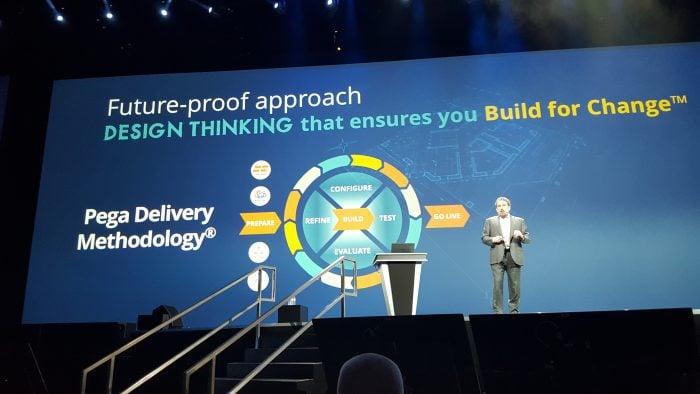Last week I attended PegaWorld 2018, one of the best tech conferences I’ve been to in years. Kudos to the event staff for producing a first-class event, and for arranging for me to meet with Pega executives and customers.
My motivation for attending was to try to figure out where Pega fits in the tech landscape. Pega’s roots are in workflow and BPM (Business Process Management) where it has been recognized as a leader for years. But things got fuzzier — and more interesting — when Chordiant was acquired in 2010. That gave Pega an entry into the huge CRM market with “decisioning” technology that would become part of what Pega now calls the Customer Decision Hub.
Another key acquisition was OpenSpan in 2016, bringing so-called Robotic Process Automation (RPA) into the platform. I say so-called because the “Robotic” part of RPA is just marketing-speak that the industry has adopted to make process automation sound more interesting. What RPA (and its desktop cousin RDA) offer is a way to connect disparate processes that require manual work. Copying information from one system to another and other types of “swivel chair” integration.
So now Pega can compete with mainstream CRM vendors, using analytics technology like you might find at IBM or SAS, and stitch together backend processes like NICE or Genesys. See what I mean? Not easy to “slot” Pega into one category anymore.
The Need for Speed
The big announcement was Pega Infinity™, the latest evolution of the company’s platform. In a roundtable discussion with founder/CEO Alan Trefler, he called it a “very significant advance in empowering customers.” As I learned at the conference, that’s the philosophy driving Trefler and team — provide tools to enable IT leaders to deliver “digital transformation” faster.

The key is the platform. I know, I know, everyone has a platform, but Pega is rare in that it’s really one code base. Fully integrated (or “unified” in Pega-speak), not bolted together like many IT vendors do. As I was told, Chordiant and OpenSpan capabilities were re-coded into the Pega platform. The Infinity release is, to my non-technical mind, more of an evolution of the platform. (Which makes me wonder what they will call the next release — “Infinity and Beyond”?)
The point: one unified platform means it’s faster to get applications up and running, with custom logic (from BPM) and intelligence (from Chordiant) and even backoffice work (thank you, OpenSpan). It’s also possible to use Pega as a kind of umbrella application, to integrate other CRM, ERP, or legacy applications. Or, embed Pega workflow into existing applications like, say, Salesforce.com.
But one thing concerned me. Code generators are nice to get something going fast, but they typically don’t perform well. How was Pega able to satisfy high-performance requirements from big brands like AMEX? A Pega sales consultant explained that high performance was delivered using a combination of caching and a custom, in-memory database design (not a conventional relational database like MySQL).
Digital Transformation
There was much discussion about digital transformation (DX) at PegaWorld, for obvious reasons. Pega is selling a platform to enable DX.
Digital transformation is a lot of syllables to say automation, in my opinion. We’ve been automating processes for decades. The thrust of most DX discussions, to be blunt, is how to get rid of people. The premise seems to be: anything that can be automated, should be automated.
Which makes me wonder… are business leaders actually designing experiences, including the role of humans who are critical to creating memorable experiences? Or just automating because it’s possible?
I put that question to a panel of IT leaders and was pleasantly surprised that they’re taking a thoughtful approach. One executive said it’s important not to equate digital transformation with self-service. In some cases, the best use of tech is to empower agents to do their job better, not to replace them with robots.
Thank you.
What’s Missing?
One thing I found refreshing about PegaWorld and the Pega people I met with — lack of hype. Ok, I did poke at “Infinity” but that aside, the Pega culture was open and straightforward. When I asked detailed questions, I got detailed answers, not marketing buzzwords. I’m sure that’s a reflection of Trefler, a very smart man for sure but doesn’t see the need for Silicon Valley-style chest thumping. Instead, he lets Pega customers do the bragging.
We could use more vendors like Pega that evolve to meet customer needs and don’t feel constrained by the lines drawn around traditional industry categories. Instead of PowerPoint integration, you get one and only one platform that makes it easy to create and change applications, and to run them in challenging environments. And, as I said, all this done without hype. Nice.
Disclosure: This post is part of my independent coverage of industry developments, and no endorsement is implied for Pega or any other company mentioned. Pega paid my hotel expenses, gave me a free conference pass, and arranged interviews. Pega has been a CustomerThink sponsor within the past year.



